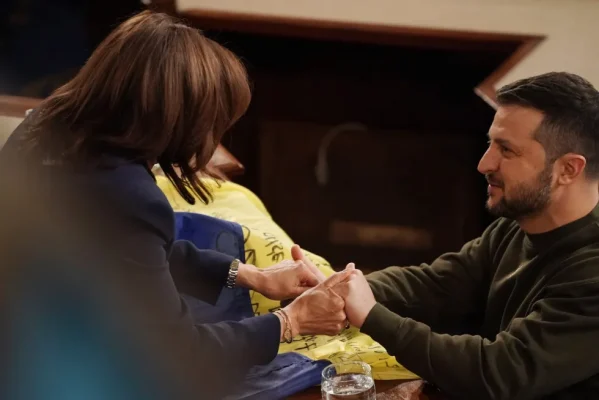Alberto Velasco Rosado and Marcos de la Rocha
It is one year since February 24, 2022, the date on which Russian political leader Vladimir Putin would initiate ‘the all-out offensive’ against his neighboring country, Ukraine.
«I have made the decision for a military operation», was the phrase with which Putin began what has been one of the most shocking recent conflicts worldwide since World War II.
Many cities have been bombed and are still suffering the consequences today. The city of Mariupol, internationally recognized as part of Ukraine, but controlled by Russia, would be the first to suffer the attacks, the first on a school where 400 Ukrainian civilians were housed, as well as a children’s hospital.
The capital Kiev, Sloviansk, Donetsk, Kharkov, Odessa, Lugansk, Kherson, Kramatorsk, Lutsk, Dnipro and Mariupol are some of the regions attacked by the Russian army.
The first sanction for Russia would come from Swift, the system that facilitates the movement of capital between international countries. The European Union entered the scene by immobilizing goods to Russia and restricting free movement in countries that are recognized by that political community.
«Europe has more sanctions on the table», Josep Borrel, the EU’s High Representative for Foreign Affairs and Security Policy, declared at the beginning of the invasion.
Four days after the invasion, the first talks between the Ukrainian and Russian delegations on the situation took place, Russian state media reported. Several meetings followed to negotiate humanitarian corridors and an end to the war, but to no avail. It was then that Volodymyr Zelensky, President of Ukraine, expressed his intention to meet personally with the President of Russia to hold negotiations, but that has never happened.
On March 4, 2022, came one of the turning points of this War, as Russia would attack the largest nuclear power plant in Southern Europe, Zaporiyia, and only five days later took control of the Chernobyl plant. Dmytro Kuleba, Ukraine’s foreign minister, told Reuters that Ukraine had three objectives in the peace talks: a ceasefire, security guarantees and Ukraine’s territorial integrity, but all of these were triggered by a flashpoint. The town of Bucha would suffer one of the largest massacres of the conflict, with 400 civilians killed, after Russian troops withdrew.
In April, Russia claimed to have taken possession of Mariupol and also ordered the launching of missiles after learning that Ukrainian civilians had been evacuated from the locality of Azovstal. The offensive for the Donbas was gaining momentum, and the city of Severodonetsk would be the next to suffer the consequences with the destruction of all the bridges of the Azot plant.
One of the days that will be marked in this war will be the day of Russia’s annual Victory Day parade on May 9. President Vladimir Putin reiterated his accusation that the West left him no choice but to invade Ukraine. He offered few clues about the direction of the conflict. The White House described Putin’s accusations about NATO threats to Russia as «patently false and absurd.»
The Russian military made the decision to attack through southern Ukraine, with massive shelling especially in the city of Dnipro, close to the Crimean peninsula. All this, before agreeing to export grain through a sea corridor and Ukrainian troops advanced to Kherson, after days of shelling on the bridges of the Dnieper River. The first grain export ship was to leave the commercial port of Odessa on the Black Sea.
After Ukraine’s major offensive on the city of Kherson, there were accusations between the two countries of attacking the nuclear power plant and the Russian president on national television accusing Western countries of seeking the destruction of Russia.
It was here that in December, Ukrainian President Volodymyr Zelensky traveled to the United States to meet with Joe Biden, the American president, in what was to be his first diplomatic offensive and his first state visit outside the country since the beginning of the war.
«Ukraine will never surrender», to the applause of the entire American Congress. The U.S. advanced military foresight in Ukraine after the president signed the 2022 Lend-Lease Act in defense of democracy in Ukraine.
As early as January 2023, two of the countries that make up the UN, Germany and the United States sent Leopard and Abrams tanks to Ukraine, while the Russian capital, Moscow, publicly announced the seizure of Soledar, near Bakhmut.
At the beginning of February, the battle for Bakhmut would begin and Zelenski visited the British parliament insisting on helping his country with aircraft to resist the invasion. Only one day later he would visit the European Parliament in Brussels.
The death toll in the first year of the war is 180,000 dead in the ranks of the Russian army, and 100,000 dead in the ranks of the Ukrainian army.
At present we do not know the date of the end of this war, but as the UN Secretary General said in an interview with CNN: »the war will not end with meetings, it will end when the Russian Federation decides». What we are currently experiencing has not happened since 1999, the last war fought on the ground was in Kosovo, and it involved NATO and Yugoslavia.










